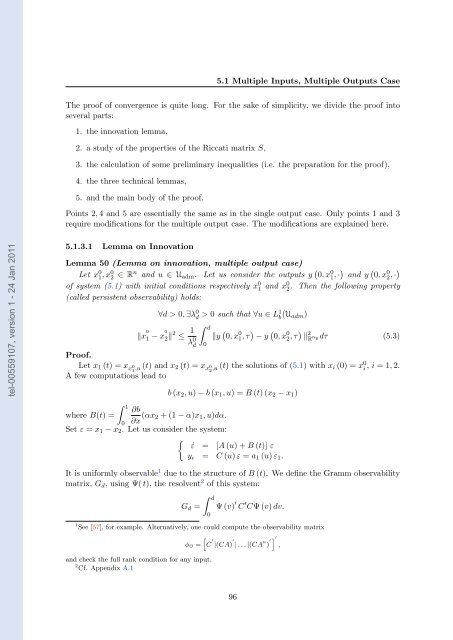Adaptative high-gain extended Kalman filter and applications
Adaptative high-gain extended Kalman filter and applications
Adaptative high-gain extended Kalman filter and applications
Create successful ePaper yourself
Turn your PDF publications into a flip-book with our unique Google optimized e-Paper software.
tel-00559107, version 1 - 24 Jan 2011<br />
5.1 Multiple Inputs, Multiple Outputs Case<br />
The proof of convergence is quite long. For the sake of simplicity, we divide the proof into<br />
several parts:<br />
1. the innovation lemma,<br />
2. a study of the properties of the Riccati matrix S,<br />
3. the calculation of some preliminary inequalities (i.e. the preparation for the proof),<br />
4. the three technical lemmas,<br />
5. <strong>and</strong> the main body of the proof.<br />
Points 2, 4 <strong>and</strong> 5 are essentially the same as in the single output case. Only points 1 <strong>and</strong> 3<br />
require modifications for the multiple output case. The modifications are explained here.<br />
5.1.3.1 Lemma on Innovation<br />
Lemma 50 (Lemma on innovation, multiple output case)<br />
Let x0 1 ,x02 ∈ Rn <strong>and</strong> u ∈ Uadm. Let us consider the outputs y � 0,x0 1 , ·� <strong>and</strong> y � 0,x0 2 , ·�<br />
of system (5.1) with initial conditions respectively x0 1 <strong>and</strong> x02 . Then the following property<br />
(called persistent observability) holds:<br />
Proof.<br />
∀d >0, ∃λ0 d > 0 such that ∀u ∈ L1 b (Uadm)<br />
� d<br />
�y � 0,x 0 1, τ � − y � 0,x 0 2, τ � � 2 ny R dτ (5.3)<br />
�x 0<br />
1 − x 0<br />
2� 2 ≤ 1<br />
λ 0 d<br />
0<br />
Let x1 (t) =x x 0 1 ,u (t) <strong>and</strong> x2 (t) =x x 0 2 ,u (t) the solutions of (5.1) with xi (0) = x 0 i<br />
A few computations lead to<br />
b (x2,u) − b (x1,u)=B (t)(x2 − x1)<br />
� 1 ∂b<br />
where B(t) =<br />
0 ∂x (αx2 + (1 − α)x1,u)dα.<br />
Set ε = x1 − x2. Let us consider the system:<br />
�<br />
˙ε = [A (u)+B (t)] ε<br />
yɛ = C (u) ε = a1 (u) ε1.<br />
, i =1, 2.<br />
It is uniformly observable1 due to the structure of B (t). We define the Gramm observability<br />
matrix, Gd, using Ψ( t), the resolvent2 of this system:<br />
� d<br />
Gd = Ψ (v) ′ C ′ CΨ (v) dv.<br />
1 See [57], for example. Alternatively, one could compute the observability matrix<br />
φO =<br />
<strong>and</strong> check the full rank condition for any input.<br />
2 Cf. Appendix A.1<br />
0<br />
�<br />
C ′<br />
|(CA) ′<br />
| . . . |(CA n ) ′�′<br />
,<br />
96

















